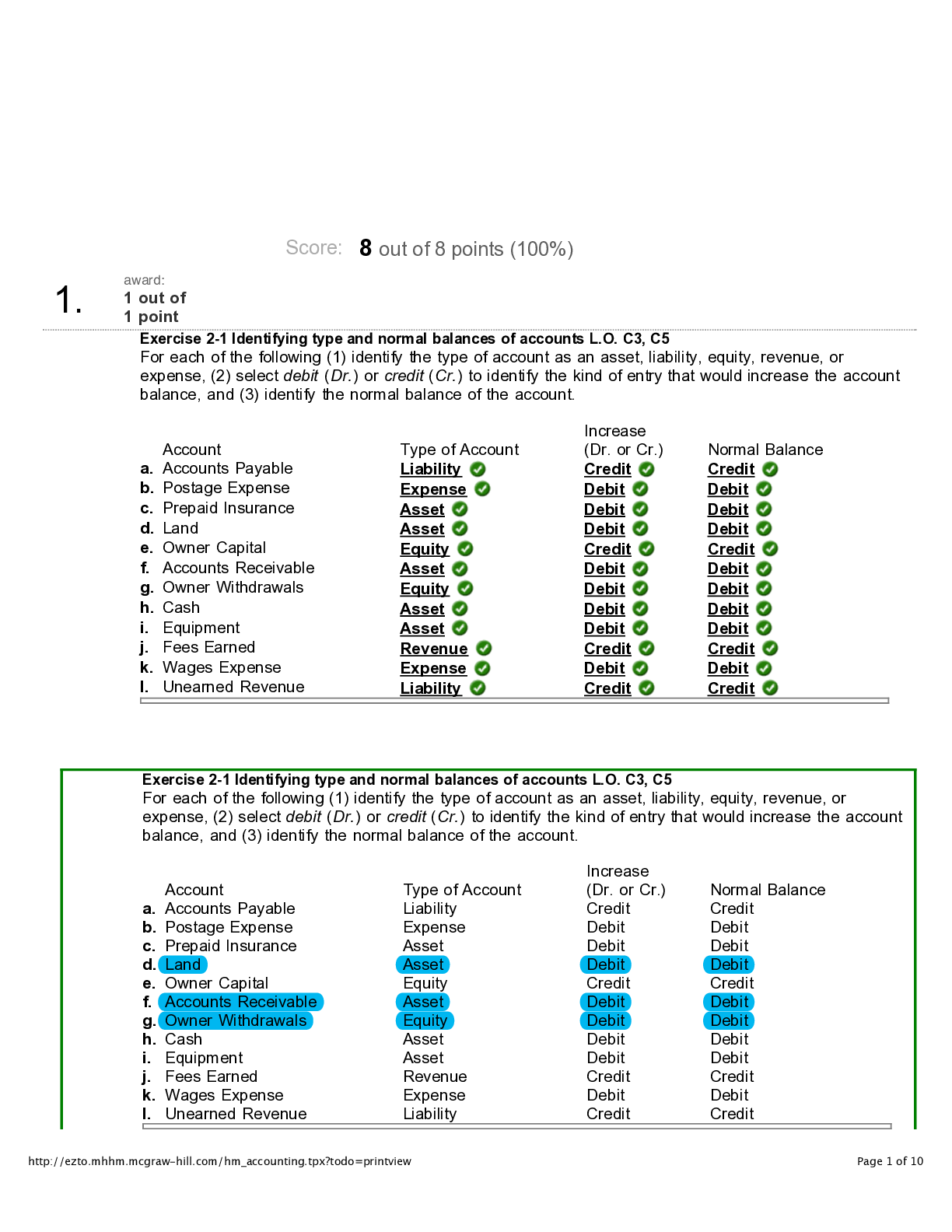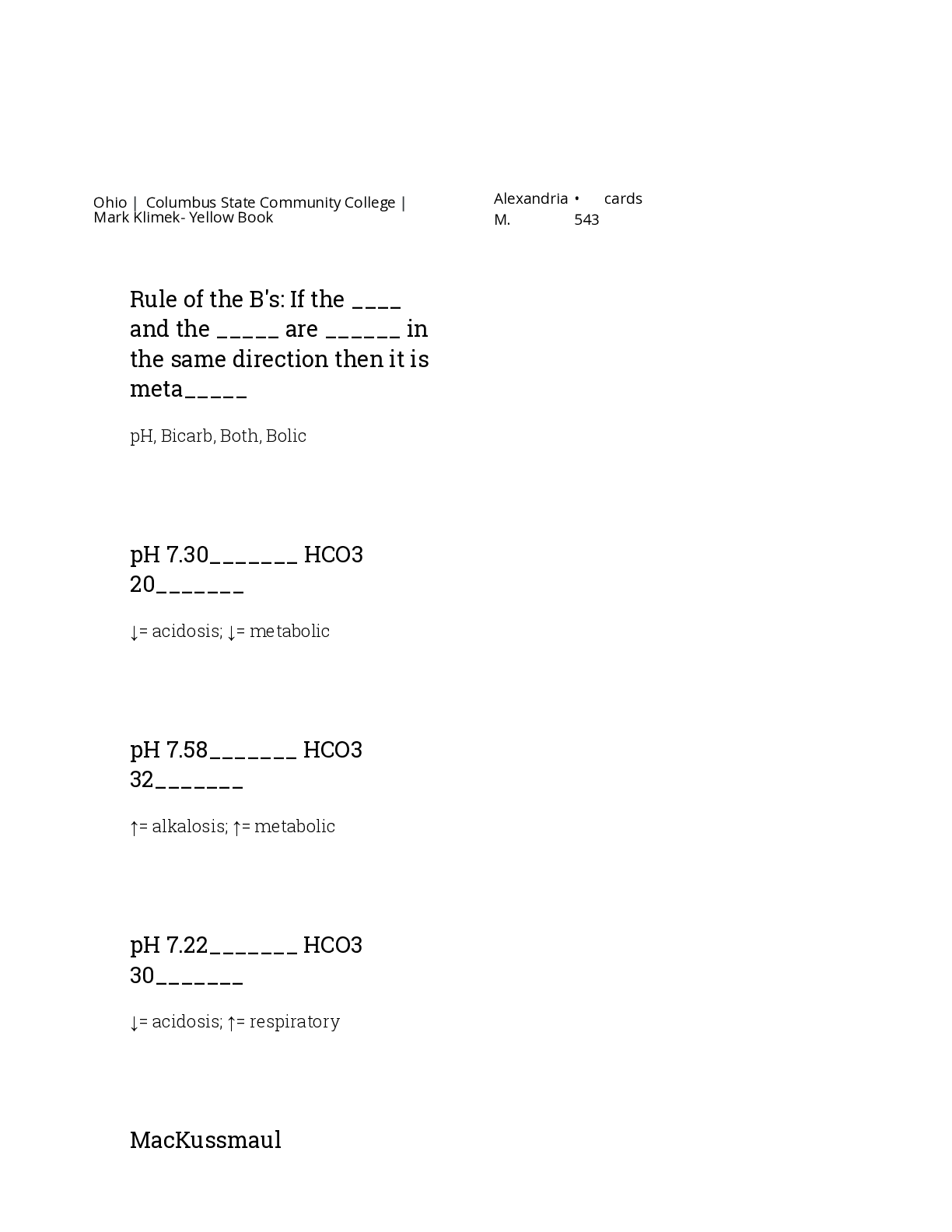*NURSING > QUESTIONS & ANSWERS > NUR 2212Neuro Evolve Questions and Answers. (Rationale Provided) (All)
NUR 2212Neuro Evolve Questions and Answers. (Rationale Provided)
Document Content and Description Below
A nurse is caring for a group of clients with myasthenia gravis, Guillain-Barré syndrome, and amyotrophic lateral sclerosis (ALS). Which information should the nurse consider when planning care for t... his group of clients? 19. The family member of a client with newly diagnosed Guillain-Barré syndrome comes out to the nurse's station and informs the nurse that the client is having difficulty breathing. What is the first action the nurse should do? 29. A client is admitted to the hospital with a diagnosis of acute Guillain-Barré syndrome. Which assessment is priority? 30. What nursing intervention is anticipated for a client with Guillain-Barré syndrome? A client with Guillain-Barré syndrome has been hospitalized for three days. Which assessment finding would the nurse expect and need to monitor frequently in this client? A client is admitted to the hospital with a tentative diagnosis of Guillain-Barré syndrome. Which question by the nurse will best elicit information that supports this diagnosis? During the neurologic assessment of a client with a tentative diagnosis of Guillain-Barré syndrome, what does the nurse expect the client to manifest? Which is the priority assessment for the client with Guillain-Barré syndrome with rapidly ascending paralysis? 35. A nurse is caring for a client newly diagnosed with Guillain-Barré syndrome. The nurse expects which procedure will be considered as a treatment option? A nurse is caring for a client with the diagnosis of Guillain-Barré syndrome with nasal cannula oxygen. The nurse identifies that the client is having difficulty expectorating respiratory secretions. What should be the nurse's first intervention? 37. A nurse is caring for a client with Guillain-Barré syndrome. The nurse should prepare the client for what essential care related to rehabilitation? The respiratory status of a client with Guillain-Barré syndrome progressively deteriorates, and a tracheostomy is performed. Nasogastric tube feedings are prescribed. How should the nurse manage the tracheostomy cuff? 39. Which immunomodulatory is beneficial for the treatment of clients with multiple sclerosis? Which cytokine is used to treat multiple sclerosis? During an exacerbation of multiple sclerosis a client reports urinary urgency and frequency. What is the most appropriate initial nursing action? Steroid therapy is prescribed for a client with common signs and symptoms of multiple sclerosis. In response to the steroid therapy, what symptom does the nurse expect to decrease? An ambulatory client with relapsing-remitting multiple sclerosis is to receive every-other-day injections of interferon beta-1a. What adverse effects does the nurse explain may occur when taking this medication? Select all that apply. 45. A nurse is teaching a client with multiple sclerosis about the disease. Which statement by the client indicates to the nurse that further teaching is needed? A client with multiple sclerosis is admitted to the hospital. The client's exacerbations have become more frequent and more severe. One day, the client's partner confides to the nurse, "Life is getting very hard and depressing, and I am upset with myself for thinking about a nursing home." After listening to the partner's concerns, which is the best response by the nurse? A client exhibits blurred and double vision and muscular weakness, and diagnostic tests are prescribed. The client is informed that a diagnosis of multiple sclerosis (MS) has been made. The client becomes visibly upset. How should the nurse respond? 48. A client is newly diagnosed with multiple sclerosis. The client is obviously upset with the diagnosis and asks, "Am I going to die?" Which is the nurse's best response? 2 "Is your family here? I would like to explain your disease to all of you." 4 "Why don't you speak with your healthcare provider? You probably can get more details about your disease." 49. A client recently diagnosed with multiple sclerosis says, "I had planned to get married before the end of the year. After this diagnosis, I might not be ready. Maybe I should call off the wedding." Which is the best response by the nurse? 50. A nurse is assessing a client with multiple sclerosis. Which common initial clinical effects should the nurse expect to find? Select all that apply. 51. A client with the diagnosis of multiple sclerosis (MS) develops hand tremors. When performing a history and physical assessment, which finding should the nurse expect the client to report? A client with the diagnosis of multiple sclerosis experiences a sudden loss of vision and asks the nurse what caused it to happen. The nurse considers the common clinical findings associated with multiple sclerosis before responding. Which is the most probable cause of the client's sudden loss of vision? 55. Which clinical findings does the nurse anticipate a client with an exacerbation of multiple sclerosis will experience? Select all that apply. 56. A client with multiple sclerosis is in remission. Which diversional activity should the nurse encourage that best meets the client's needs while in remission? A recently hospitalized client with multiple sclerosis is concerned about generalized weakness and fluctuating physical status. What is the priority nursing intervention for this client? The nurse is teaching a client with multiple sclerosis methods to reduce fatigue. Which statement indicates an understanding of the education? A client who was in a traffic accident is choking. The nurse suspects that the client may have a spinal cord injury. Which procedure may benefit the client? 61. The nurse is providing care to a client with a neck and spinal cord injury. Which is the priority when moving this client during the assessment process? The nurse finds that a client with a spinal cord injury has developed sudden autonomic dysreflexia. What is the priority nursing action in this situation? 63. A client who sustained a spinal cord injury experienced an episode of autonomic dysreflexia. Which intervention should the nurse perform first? A nurse is caring for a client with a spinal cord injury during the immediate postinjury period. Which is the priority focus of nursing care during this immediate phase? After a client is treated for a spinal cord injury, the healthcare provider informs the family that the client is a paraplegic. The family asks the nurse what this means. Which explanation should the nurse provide? 69. A client has sustained a spinal cord injury at the T2 level. The nurse assesses for signs of autonomic hyperreflexia (autonomic dysreflexia). What is the rationale for the nurse’s assessment? The nurse is caring for a client with a spinal cord injury. Which assessment findings alert the nurse that the client is developing autonomic hyperreflexia (autonomic dysreflexia)? Which responses should alert the nurse that a client with a spinal cord injury is developing autonomic dysreflexia? A nurse plans to monitor for signs of autonomic dysreflexia in a client who sustained a spinal cord injury at the T2 level. Why is this necessary? A nurse is caring for a client with a spinal cord injury. What is the specific reason fluid intake should be increased for this client? The nurse is caring for a client with a spinal cord injury. The client exhibits signs of autonomic 76. The nurse is caring for a client one week after the client experienced a spinal cord injury at the T3 level. What is an appropriate short-term goal for this client? 1 "The client will understand limitations." 2 "The client will consider lifestyle changes." 3 "The client will perform independent ambulation." 77. The primary reason the nurse encourages a client with a spinal cord injury to increase oral fluid intake is to prevent which problem? 78. A client who is recuperating from a spinal cord injury at the T4 level wants to use a wheelchair. What should the nurse teach the client to do in preparation for this activity? 79. The nurse is caring for a client with a spinal cord injury who has paraplegia. The nurse can expect which major problem early in the recovery period? 80. The nurse is caring for a client in active labor with a history of T5 spinal cord injury. Which of the following findings indicates to the nurse that the client is experiencing a complication of the labor process? A young adult sustained a spinal cord injury at the level of T5 a week ago and is now incontinent of feces. When the nurse tries to give a bath and change the linens, the client says, "Leave me alone. It's worse having you change me than it is to lie in this mess." What is the best response by the nurse? 1 "Do you want me to get someone else to change you?" 2 You shouldn't be embarrassed; this is part of my job." 3 "I'll be back in a little while; why don't you rest until then?" A client is admitted to the emergency department with the diagnosis of a possible spinal cord injury. The nurse should monitor the client for what clinical manifestations of spinal shock? Select all that apply. 5 Increased pulse pressure A nurse is caring for a client who has paraplegia as a result of a spinal cord injury. Which rehabilitation plan will be most effective for this client? 1 Arrangements will be made by the client and the client’s family. Two weeks after sustaining a spinal cord injury, a client begins vomiting thick coffee-ground material and appears restless and apprehensive. What is the most important initial nursing action? 88. A nurse is caring for a client who reports urinary problems, and the healthcare provider prescribes a cholinergic medication. Which urinary problem will this medication correct? 90. 96. Which statement regarding treatment with interferon indicates that the client understands the nurse's teaching? What is the immediate nursing intervention for a client experiencing autonomic dysreflexia? 1 Administering an alpha blocker The nurse is caring for a client with autonomic dysreflexia. What should be the nurse’s immediate action to manage the client’s condition? 100. The nurse is conducting a brief neurologic examination to test the level of consciousness in a client who sustained injuries in a bus accident. Which order should the nurse follow to assess the client’s condition? A nurse is teaching a client with multiple sclerosis (MS) about how to manage urinary retention. Which instructions should the nurse include in the teaching session? Select all that apply. 54. A client has a diagnosis of multiple sclerosis and is currently in remission. The client is a parent of two active preschoolers. What should the nurse encourage the client to do? 71. A young man who sustained a spinal cord injury at the cervical level expresses concern about sexual functioning. What should the nurse do when counseling this client? A young adult client is hospitalized with a spinal cord injury. The client, knowing that the paralysis may be permanent, says, "I wish God would end my suffering and take me." What is the most therapeutic initial response by the nurse? A client has a functional transection of the spinal cord at C7-8, resulting in spinal shock. Which clinical indicators does the nurse expect to identify when assessing the client immediately after the injury? Select all that apply. [Show More]
Last updated: 2 years ago
Preview 1 out of 41 pages

Buy this document to get the full access instantly
Instant Download Access after purchase
Buy NowInstant download
We Accept:

Reviews( 0 )
$10.00
Can't find what you want? Try our AI powered Search
Document information
Connected school, study & course
About the document
Uploaded On
Apr 18, 2020
Number of pages
41
Written in
Additional information
This document has been written for:
Uploaded
Apr 18, 2020
Downloads
0
Views
114


.png)
.png)
.png)
.png)
.png)
.png)
.png)




